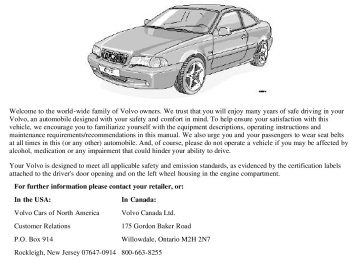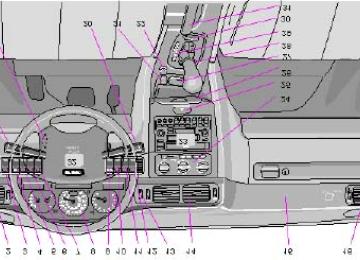- 2004 Volvo C70 Owners Manuals
- Volvo C70 Owners Manuals
- 2011 Volvo C70 Owners Manuals
- Volvo C70 Owners Manuals
- 1998 Volvo C70 Owners Manuals
- Volvo C70 Owners Manuals
- 2005 Volvo C70 Owners Manuals
- Volvo C70 Owners Manuals
- 2000 Volvo C70 Owners Manuals
- Volvo C70 Owners Manuals
- 2007 Volvo C70 Owners Manuals
- Volvo C70 Owners Manuals
- 2006 Volvo C70 Owners Manuals
- Volvo C70 Owners Manuals
- 2012 Volvo C70 Owners Manuals
- Volvo C70 Owners Manuals
- 2002 Volvo C70 Owners Manuals
- Volvo C70 Owners Manuals
- 2013 Volvo C70 Owners Manuals
- Volvo C70 Owners Manuals
- 2008 Volvo C70 Owners Manuals
- Volvo C70 Owners Manuals
- 2009 Volvo C70 Owners Manuals
- Volvo C70 Owners Manuals
- 1999 Volvo C70 Owners Manuals
- Volvo C70 Owners Manuals
- 2001 Volvo C70 Owners Manuals
- Volvo C70 Owners Manuals
- 2003 Volvo C70 Owners Manuals
- Volvo C70 Owners Manuals
- Download PDF Manual
-
Determine, in one of the following ways, if your garage door uses a rolling code system and is manufactured after 1996:
· Refer to the garage door opener's owner's manual for verification.
· The hand-held transmitter appears to program the HomeLink® Universal Transceiver but the transceiver does not activate the garage door.
· Press the programmed HomeLink® button. The garage door opener has the rolling code feature if the HomeLink® indicator light flashes rapidly and then glows steadily after approximately 2 seconds.
To train a garage door opener with the rolling code feature, follow these instructions after the transceiver has been programmed (the aid of a second person may make the training quicker and easier):
1. Locate the training button on the garage door opener motor head unit. The exact location and color of the button may vary. If you encounter difficulty, refer to the garage door opener owner's manual or call: 1-800-355-3515
(Internet: www.HomeLink.jci.com).2. Press the "training" button on the garage door opener motor head unit until the "training" light comes on.
3. Firmly press and release the programmed HomeLink® button. Press and release the HomeLink® button a second time to complete the training process.
Some garage door openers may require you to do this procedure a third time to complete the training.
The programmed button on your HomeLink® Universal Transceiver should now operate your garage door opener. The original hand-held transmitter can also be used, if necessary, to operate the garage door.
The remaining two buttons can be programmed in the same way. In the event of any problems in programming the HomeLink® Universal Transceiver, call 1-800-355-3515 (Internet: www.HomeLink.jci.com).
Operating the HomeLink® Universal Transceiver
Once programmed, the HomeLink® Universal Transceiver can be used in place of hand-held transmitters.
To operate, press the programmed HomeLink® button to activate the garage door, driveway gate, security lighting, home security system, etc.
The original hand-held transmitter can, of course, be used at any time.
Erasing programmed buttons
Individual buttons cannot be erased. To erase all three programmed buttons:
1. Hold down the two outside buttons on the HomeLink® Universal Transceiver until the indicator light begins to flash, after approximately 20 seconds.
2. Release both buttons.
The HomeLink® buttons can be reprogrammed using the procedures described on the previous page.
(HomeLink® information is continued on the next page)
pg. 188 HomeLink® Universal Transceiver (option)
Reprogramming a single HomeLink® button
1. Press and hold the desired HomeLink® button. Do not release the button until step 3 has been completed.
2. When the indicator light begins to flash slowly (after approximately 20 seconds), position the hand-held transmitter 2 to 5 in. (5 to 12 cm) away from the HomeLink® surface.
3. Press and hold the hand-held transmitter button. The HomeLink® indicator light will begin to flash, first slowly then rapidly. When the indicator light flashes rapidly, release both buttons.
The previously programmed device has now been erased and the new device can be activated by pressing the HomeLink® button that has just been programmed. This procedure will not affect any other programmed HomeLink® buttons.
NOTE:
· Retain the original transmitter(s) for future programming procedures (i.e., if you purchase a new car).
· It is also suggested that if you sell your car, the programmed channels on the HomeLink® Universal Transceiver be erased for security purposes.
Contents | Top of Page
2 0 0 0 VOLVO
C70
17
86
35
33
33
44
25
17,19,71
31182
130
143
159
48
103
24
61,62,63,64, 125
62,64
12274,126
54
120
12
17,18
116,122
18
71,72INDEX
pg. 189 - 191 Index
ABS Adjusting headlights Air conditioning Air mix Air vents Airbag (SIPS) Airbag (SRS) Alarm Ambient temperature sensor Anti-lock Brake System (ABS) Ashtrays Audio systems - General information - SC813
- SC816
- SC-900/901
Auto-dim (rear-view mirror) Automatic car washing Automatic daytime running Automatic transmission Kickdown Automatic transmission fluid Battery Battery drain - avoiding Battery maintenance Booster cushion Brake failure warning light Brake fluid Brake fluid warning light Brake system17
17,19
126125
36
77
82
12
10
12
16
25
116
60
118
19
17
66,124
20
49
29Brake warning light Bulb failure warning Bulbs Capacities Central locking button Chains (snow) Changing a wheel Child booster cushion Child Restraint Anchorages Child safety Clock Clock - resetting Clutch fluid Clutch interlock Coolant - checking/changing Coolant level sensor Coolant level warning light Cooling system Courtesy lights - exterior Courtesy lights - front Cruise control Daytime running lights Demister - rear window Dimensions Distributor ignition system Diversity antenna Doors and locks Driving economy Driving mode W EBD (Electronic Brake-force Distribution) 72
34,35
ECC - Electronic Climate Control 66,126
Electrical system 30
Electrically heated front seats 46,47
Electrically operated front seats 41
Electrically operated sun roof 36
Electrically-operated windows 72
Electronic Brake Distribution (EBD) Electronic Brake-force Distribution (EBD) 72
68
Emergency towing Emergency warning flashers 23
123
Engine24
23
127
124
185
42
58
62,64Engine compartment Engine oil Engine oil - checking/changing Engine oil pressure Exterior courtesy lights Fog light - rear Fog lights - front Front courtesy lights Front fog lights Front seats Front seats - heated Front seats - memory function Front suspension Fuel gauge Fuel level Fuel requirements Fuel system Fuel tank cover - opening opening manually Fuses Fuses - replacing Gas tank cover - opening opening manually Generator Generator warning light Hand brake Handling Hazard warning flashers Headlight adjustment Headlight wiper blades - replacing Headlights Heated front seats Heated side-view mirrors Heating Heating and air conditioning High beams Hoisting the car HomeLink® Hood Ignition switch
119
114,115,122
114
17
2017,22
22
49
22
46
30
46
124
16
17
56
124
37,57
97
91,92,93
9137,57
97
17,126
1830
67
23
86
96
20
30
23
35
33
17
110
186,187,188
5121
Immobilizer (start inhibitor) Instrument illumination Instruments Jack Jump starting Keyless entry system Keylock Keys Kick-down Kickdown Label information Lifting the car Locks Long load storage Lubrication Lumbar support Maintenance schedule Maintenance service Malfunction indicator lamp Manual transmission Manual transmission fluid Memory function - front seats Mirrors - rear/side view Occupant safety Octane rating Odometer Oil (engine) Oil pressure warning light On-call Paint touchup Parking brake Parking brake reminder light Parking lights Polishing Power seats Power steering fluid Radio
42
22
14,1553,82,83
7043
59
42
61,63
62,64106
110
42
50
113
46108
107
17,18
60,125
122
46
4813
57
16
114,115,122
18
128100
17,30
18
20
103
46,47
116,122General information SC813
SC-816
SC-900/901
Radio Data System - RDS Reading lights Rear (side) windows - opening Rear fog light Rear suspension Rear window demister Rear/side-view mirrors Refueling Remote control (central locking system) Remote keyless entry system Replacing bulbs Replacing fuses Reporting safety defects Roadholding Roof rails/racks Safety defects - reporting Seat belt maintenance Seat belts Automatic Locking Retractor Emergency Locking Retractor Seat belts - cleaning Seats Seats - heated Securing cargo Service reminder indicator Servicing Shift lock Shiftlock Shiftlock release (override) Side Impact Protection System (SIPS) Side-view mirrors - heated SIPS Snow chains Snow tires Spare tire Spare tire (sedan) Spark plugs Spark plugs - replacing Specifications182
130
143
159
164
49
37
17,22
124
23
48
57
43
43
86,87,88,89,90
91
13
67
6713
13
2,3,11
11
11
104
46
30
54
17,19
110,111,112
59
61,63
97
23
77
77
84
53
124
124
121SRS SRS diagnostic system SRS warning light Stability and Traction Control (STC) Start inhibitor (immobilizer) Starting the engine Steering wheel adjustment Steering wheel lock Storage compartments Studded tires Sun roof Tachometer Temperature gauge Temporary spare tire Tire pressure Tires - changing Towing Towing a trailer Trailer towing Trip computer Trip odometer Trunk - opening/locking Trunk light Turn signals Uniform tire quality grading Upholstery - cleaning Vanity mirrors Vehicle Identification Number (VIN) Vehicle loading Whiplash Protection System (WHIPS) WHIPS Winter/Wet driving mode Volvo On Call Warning flashers Warning lights Warranty Washer fluid level Washer fluid reservoir Washing Waxing
5,6,7
19
5,17,19
19,23,72
42
59
32
21
40
77
23,4116
16
84
78
82
68,69
73
73
23,26,27,28
16
52
53
17,2079
10449
106
125
62,64
12823
18,19
107
17
117
102
103Weights Wheel changing Wheels and tires Windows - electrically-operated Windshield washer nozzles Windshield washers/wipers Windshield wiper blades - replacing Winter driving
127
82,83
76
36
117
21
95
74Contents | Top of Page
2 0 0 0 VOLVO
C70
Back Cover
Back Cover
WARNING!
Detergents and solvents
Do not use gasoline containing lead or benzene as a detergent or solvent. Both lead and benzene are toxic and may be hazardous to your health.
Installation of optional equipment/use of mobile telephones
Incorrectly installed optional equipment, alarm systems or the use of mobile telephones which are not connected to a suitable antenna can cause faults in the car's electronic control systems. Your car is equipped with an accessory connector located under the dashboard on the driver's side. Please consult your Volvo retailer if you have any questions before connecting accessory or optional equipment to the vehicle's electrical system.
Carbon monoxide
Carbon monoxide is a poisonous , colorless and odorless gas which is present in all exhaust gases. If you ever smell exhaust fumes inside the vehicle, make sure the passenger compartment is ventilated and immediately return the vehicle to your retailer for correction.
Never sit in a parked or stopped car for any extended amount of time, nor have it unattended while the engine is running.
Never operate the engine in confined, unventilated areas.
The following should be checked regularly: *
1 Washer fluid reservoir should be filled with water and solvent (wintertime: windshield washer anti-freeze). See page 117.
2 Coolant level should be between the expansion tank marks. Mixture: 50% anti-freeze and 50% water. See page 118.
3 Power steering - When cold, the level must not be above the COLD mark and when hot it must not be above the HOT mark. Top up if the level drops to the ADD mark with ATF fluid. See page 116.
4 Engine oil level should be between the dipstick marks. The distance between the marks represents approx. 1.6 US qts (1.5 liters). See page 114.
5 Brake fluid - check, without removing the cap, that the level is above the MIN mark. Use brake fluid DOT 4+. See page 116.
* Engine oil should be checked each time the car is refuelled.
Octane rating, see page 57.
Tire pressure, see label located on the rear edge of the right front door.
H7
Bulbs Power Socket US no.
55 W - 30/7 W BA 15s 3357NA 55 W PK 22s H1
5 W BA 15s 67
21 W BAU 15 - 21 W BA 15s 1156See pages 85-87 for more detailed information.
Volvo Car Corporation
Göteborg, Sweden
TP 4360/1 (Canada & USA) 3000.07.98 Printed in Sweden, Elanders Graphic Systems AB, Göteborg 1998
Contents | Top of Page

